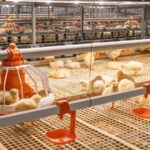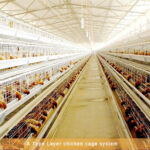Management skills when using chicken battery cages to raise chickens
Now Nigeria’s aquaculture industry is moving towards a modern, mechanized road. The farming method has also moved to a new stage and began to use chicken cage farming. Chicken cage culture is a multi-layer cage, which can increase the breeding density of farmers, and breed about three times more chickens in the original culture area. However, the farming method has improved and the management of farmers has to improve. So the author will share and use the management skills of chicken cage farming.
When the chickens are not in a new environment, they will not be able to adapt. There will always be some stress reactions, which will affect the growth of the whole group in severe cases. Therefore, farmers should pay attention to the following items when putting chickens into layer chicken cages:

1. Chickens can be changed to free drinking water and free to eat 2 to 3 days before entering the cage. Preferably, 0.01% to 0.02% of erythromycin is added to the feed, and 0.01% to 0.02% of vitamins and 5% to 8% of glucose are added to the drinking water. Only 2 to 4 hours before the transfer, the water is not fed.
2. In the case of farmed laying hens, early transfer to cage culture allows sufficient time to adapt to the new environment before opening. The authors suggest that when the laying hens are 110-120 days old, it is best to transfer them to the cages, because at this time the development of various organs, especially the reproductive organs, in the laying hens is at the peak. If the time of the group is postponed, the stress response will increase, which will affect the later production of eggs.
3. Farmers in front of cages should carefully observe the spirit, feed intake, feces, etc. of the flock. If abnormalities are found, they cannot be transferred. If individual infertile chickens have therapeutic value, they can be treated separately, and once again, they will be transferred to the group cage.
4. Because of the difference in temperature during the day, it is best to choose the farmer in the morning or evening, and the temperature can be controlled within 10~20 °C.
5. After transferring to the cage, add antibiotics and vitamins to the material and water within one week, and still keep the bottom of the cage for about 1 week. After the adaptation, the bottom of the cage is tilted to an angle that can be rolled. Generally, it does not exceed 20 °C. The bulb used is preferably more than 2.5 m2, and it is conditional to use green light within 24 hours after entering the cage.
6. To keep the flock relatively stable, strange chickens will fight each other after they enter the chicken coop, fighting for food, fighting for water, and fighting for content. This phenomenon will last for more than a month and will establish a new neighbor relationship. Therefore, when dismantling the cage, it should be as close as possible to the same shed and the same circle to avoid mixed groups.
The above six points are the management points when using chicken battery cages to raise chickens. It is hoped that farmers can seriously refer to the fact that the flocks in the cages will not affect the economic benefits of the farmers.










